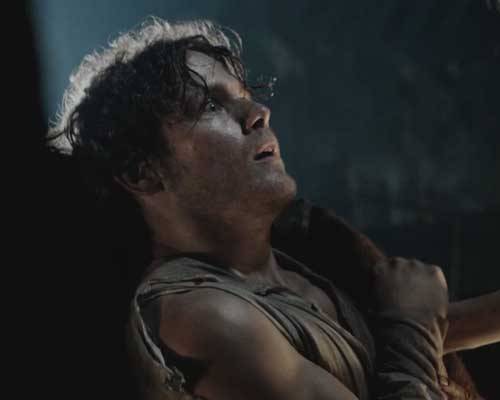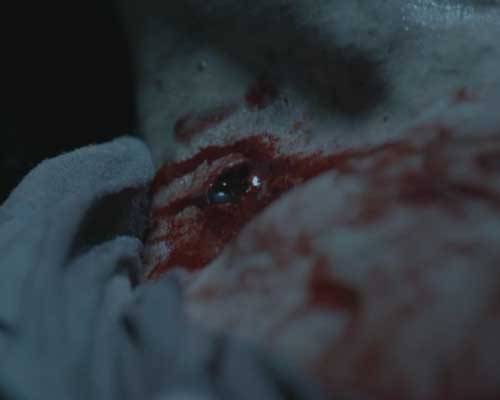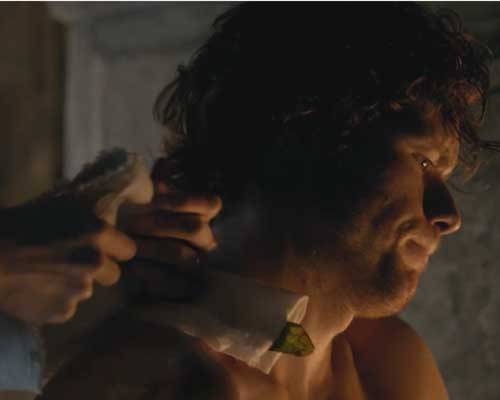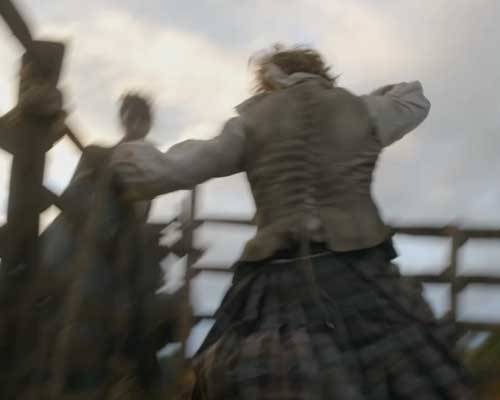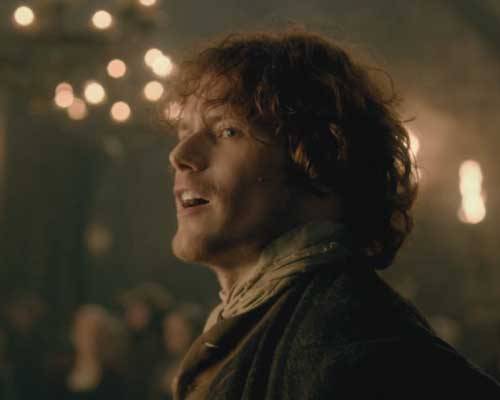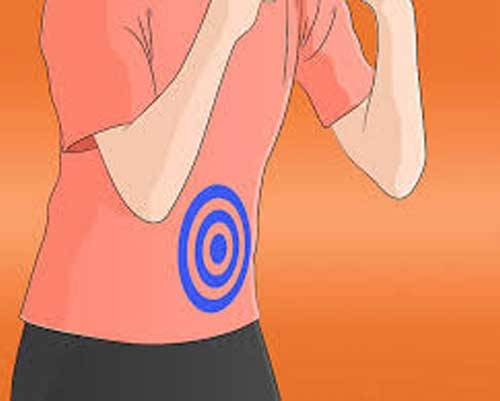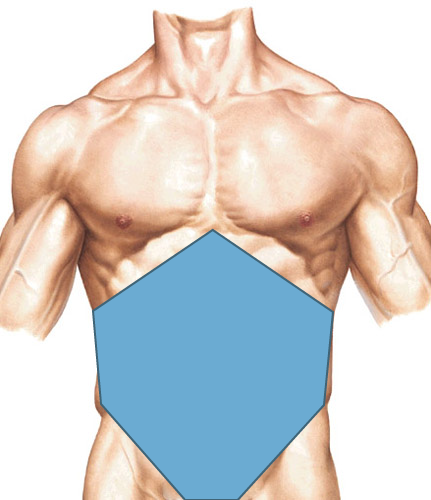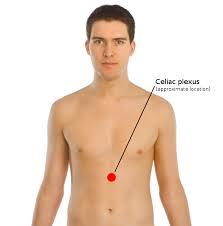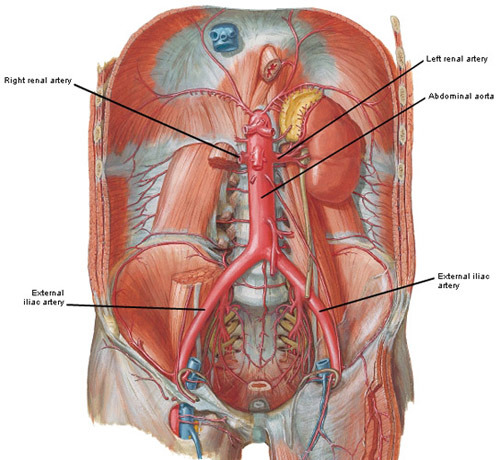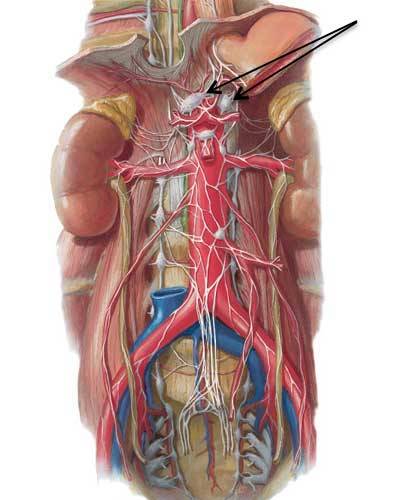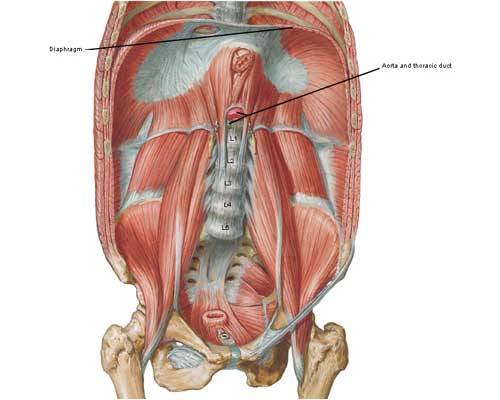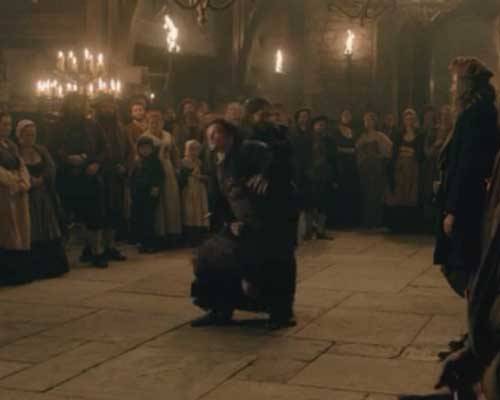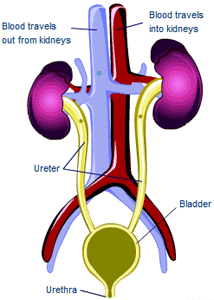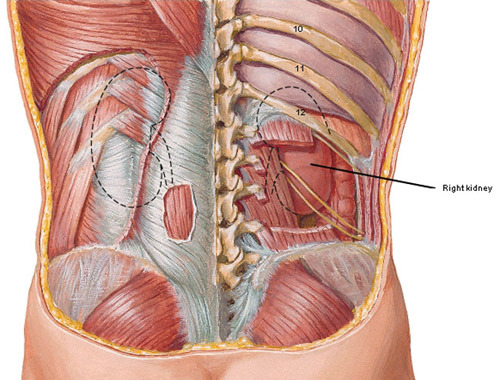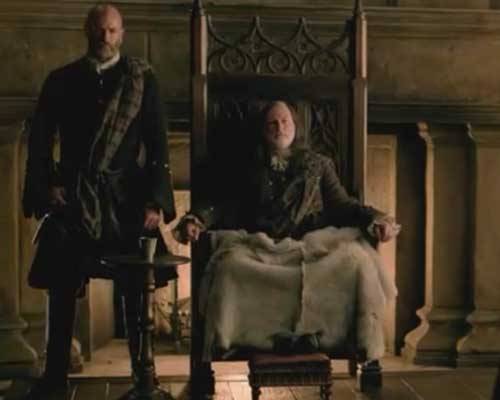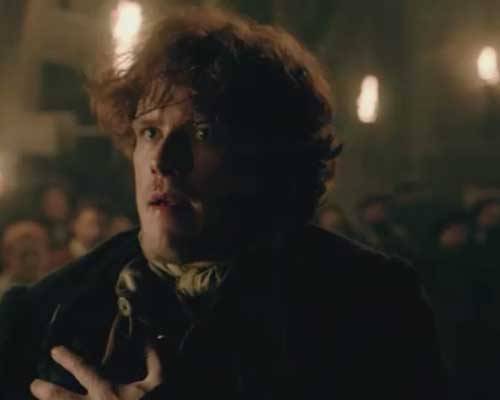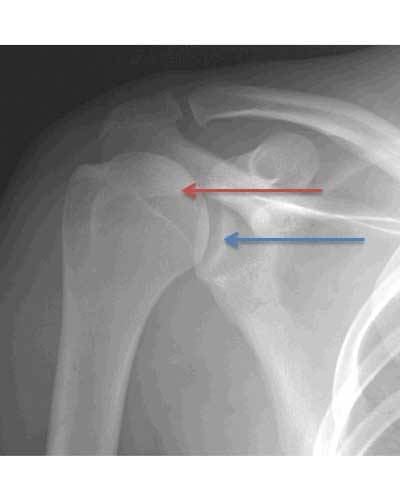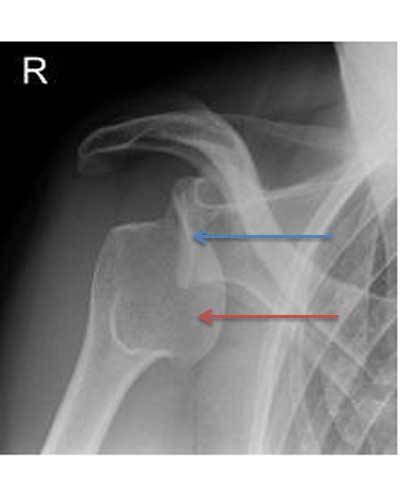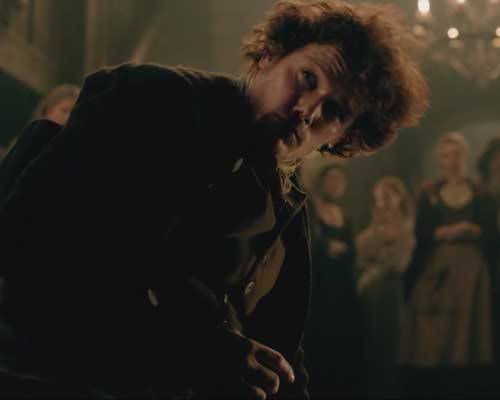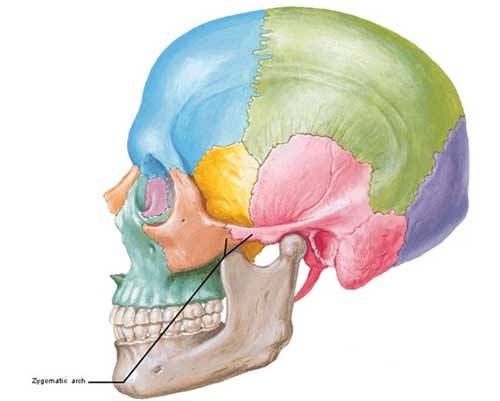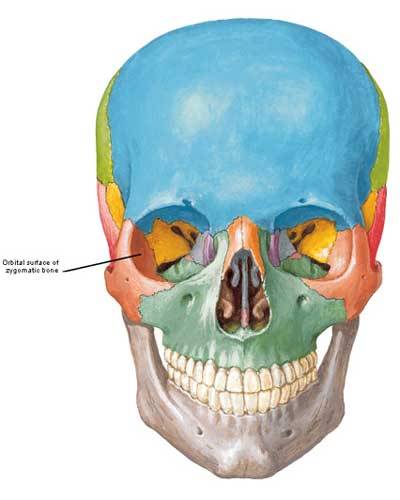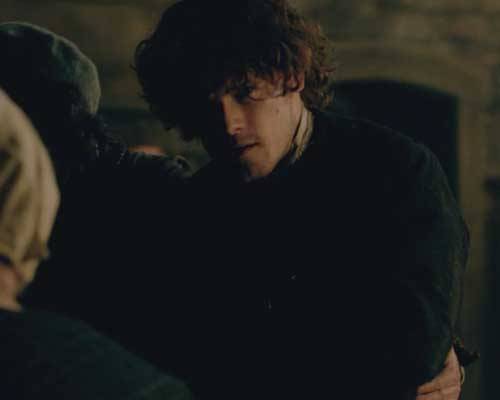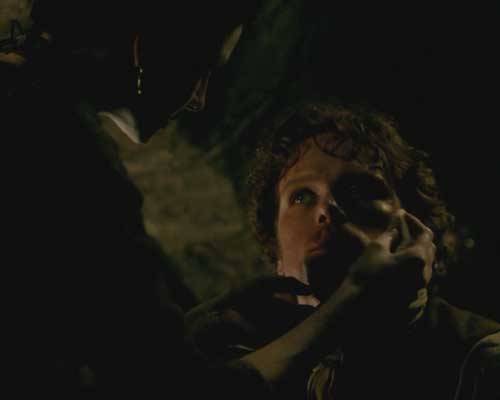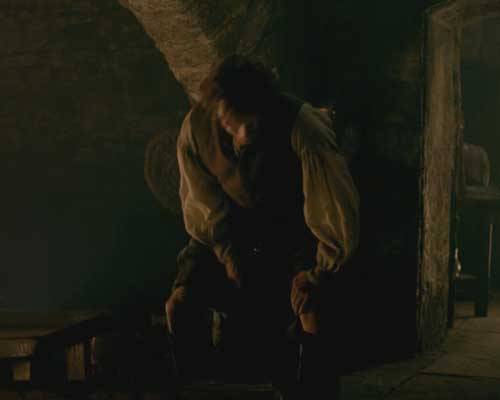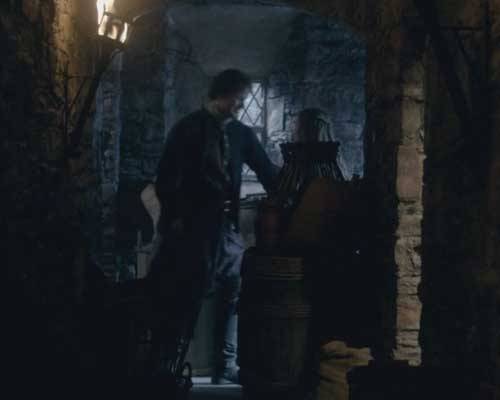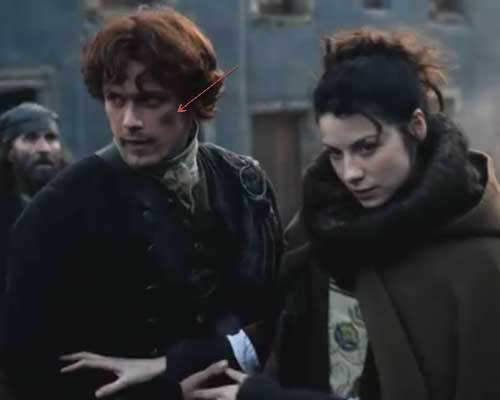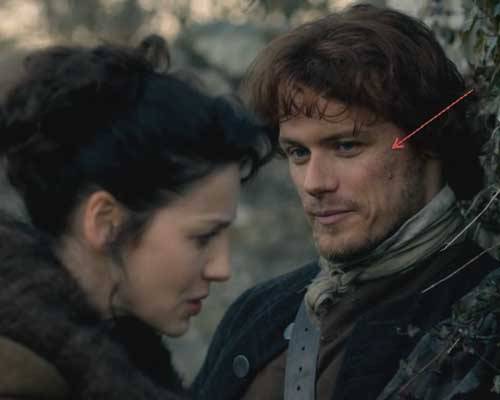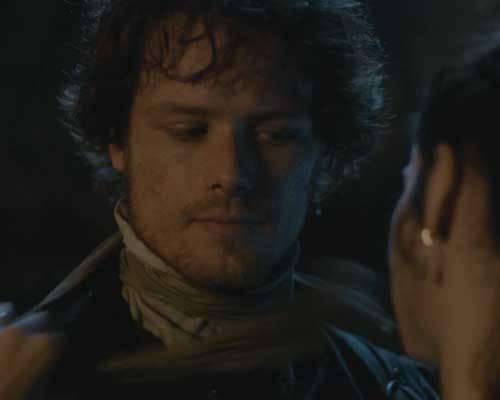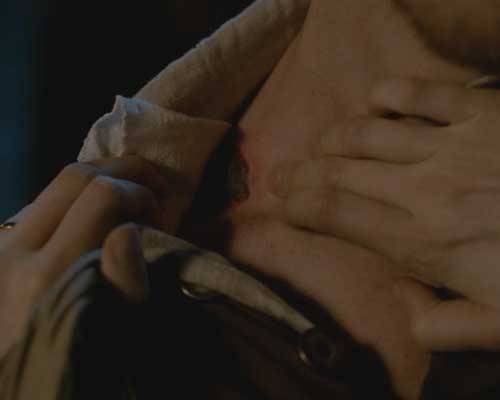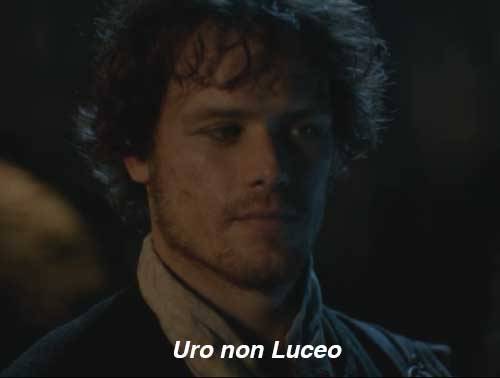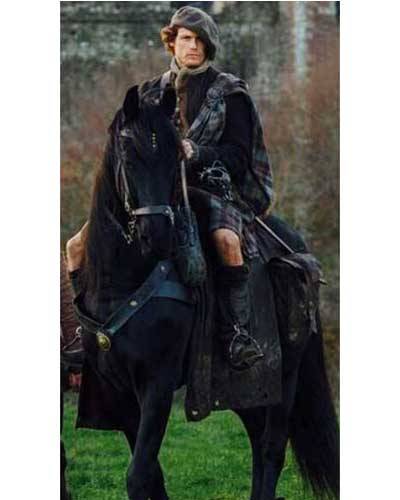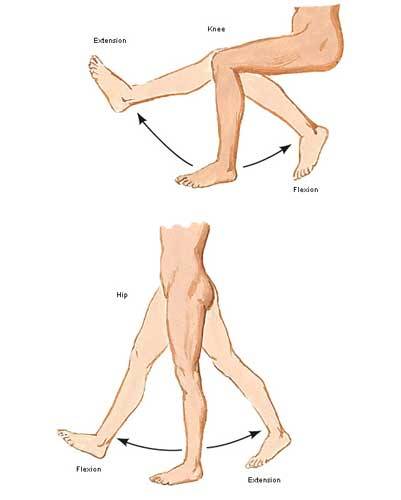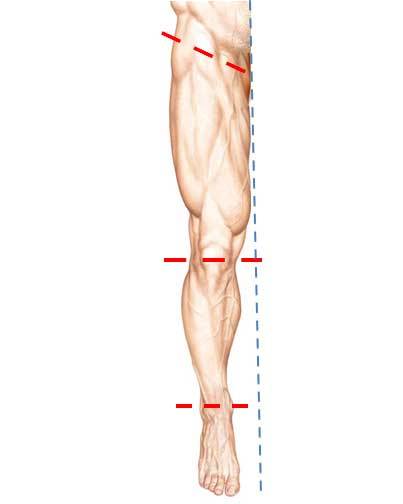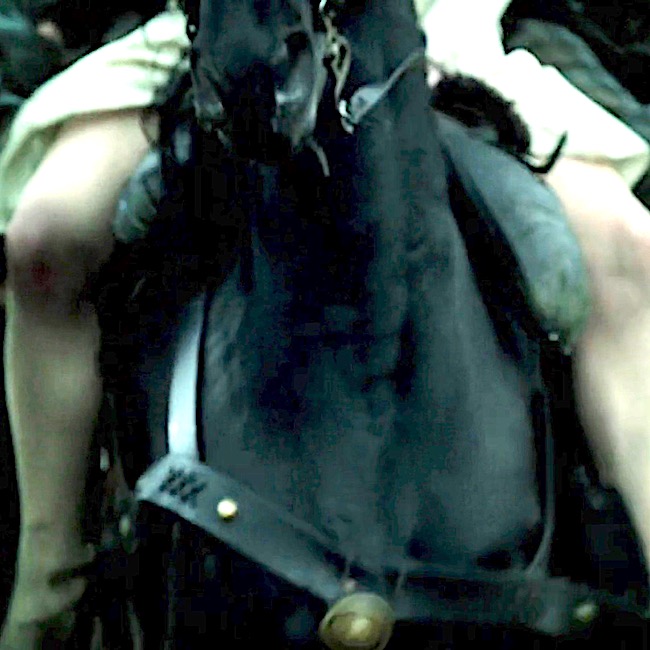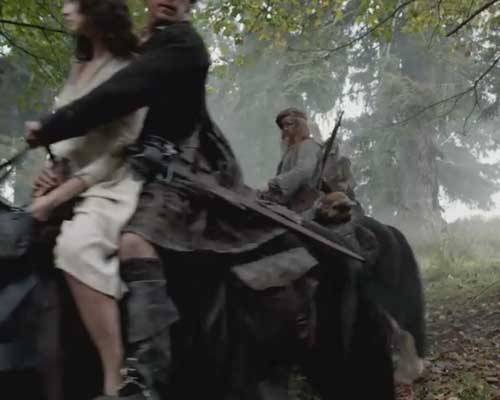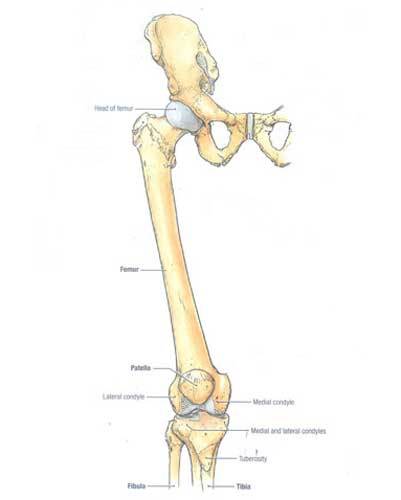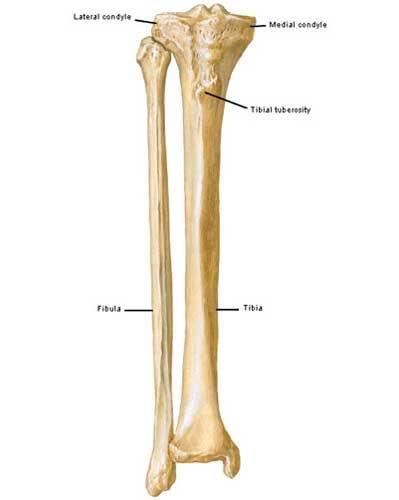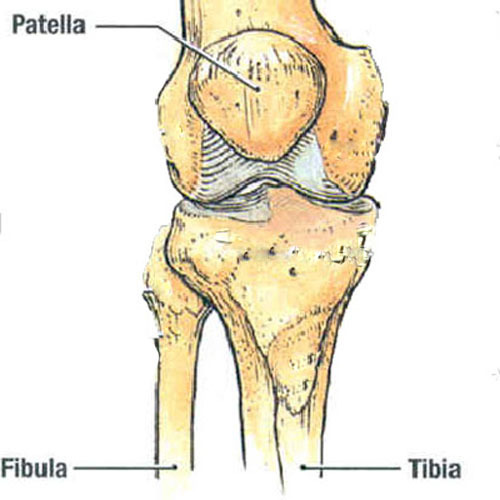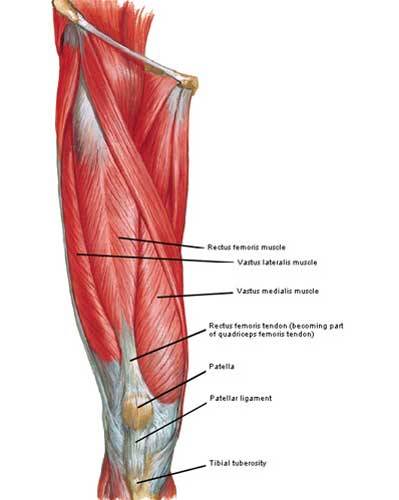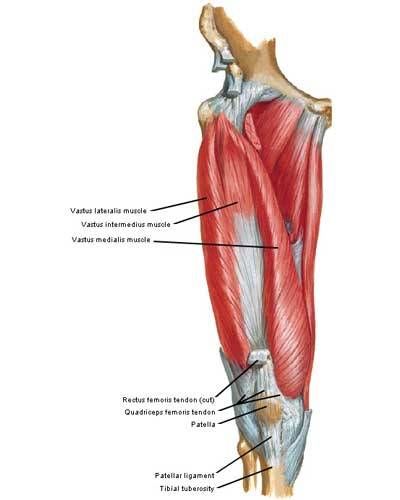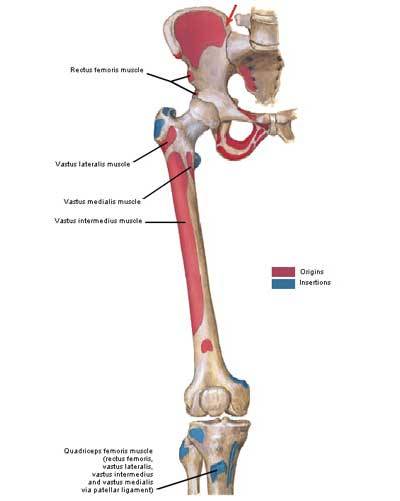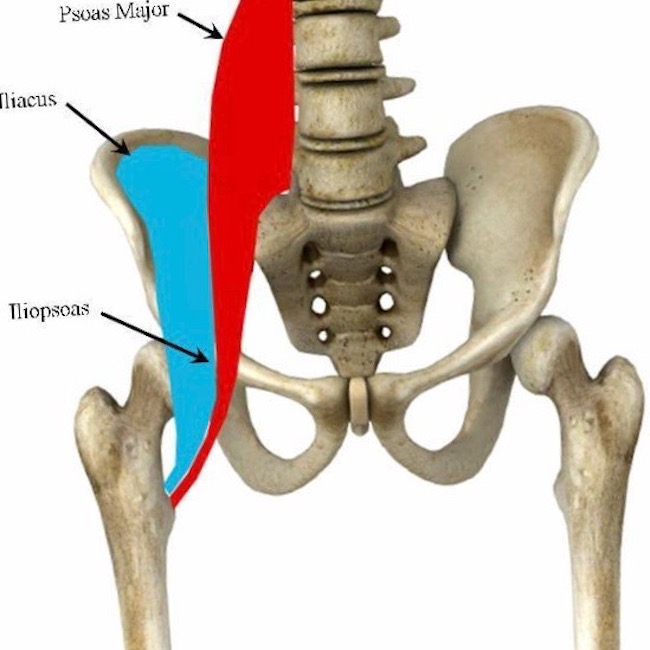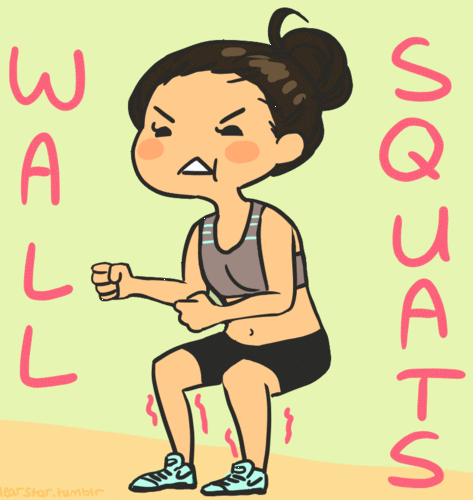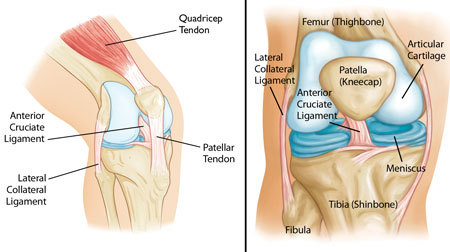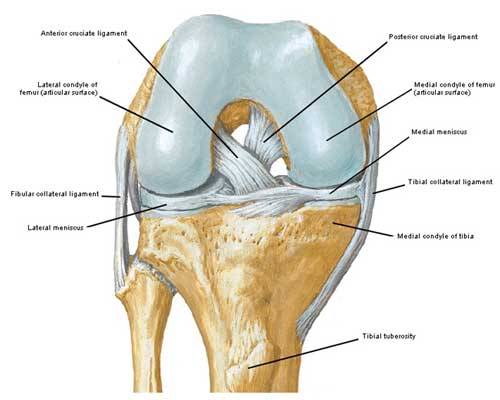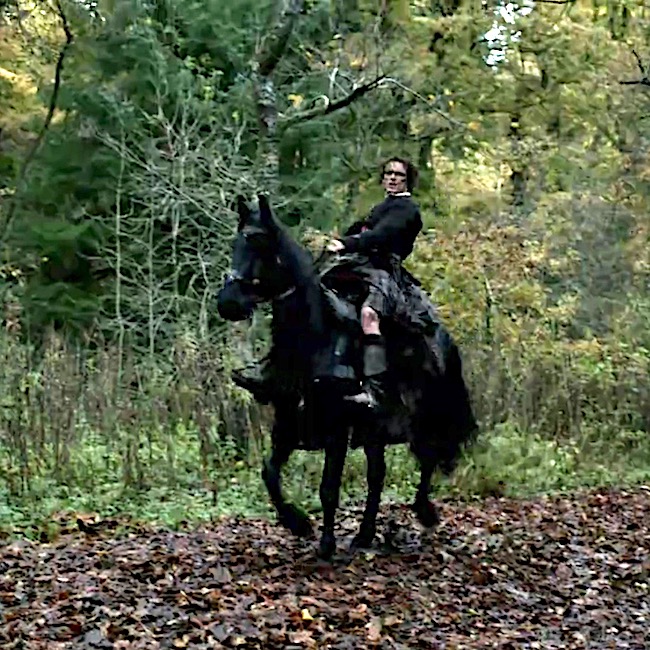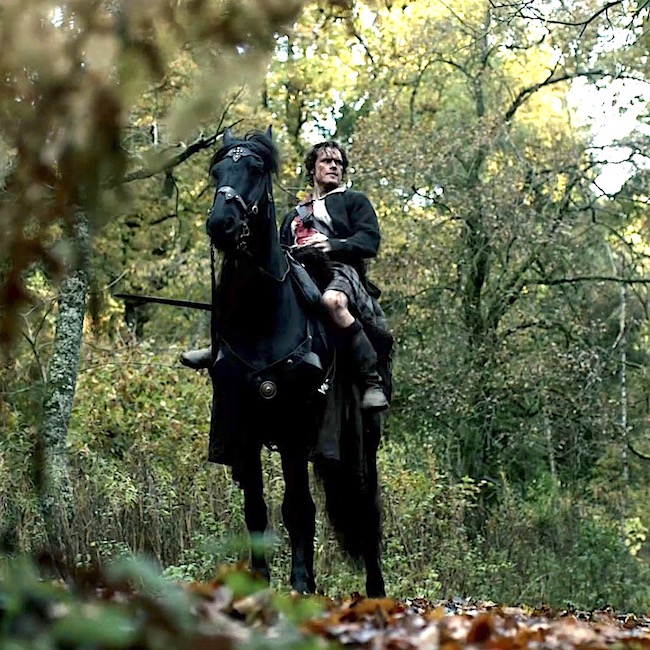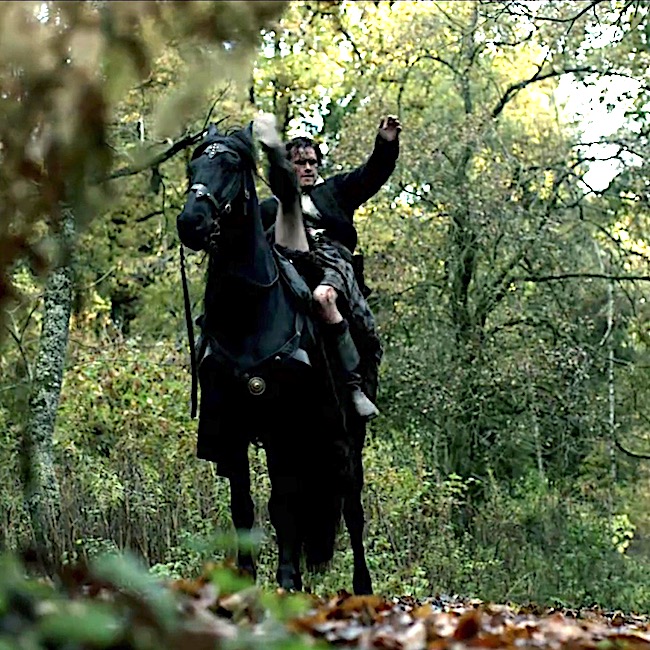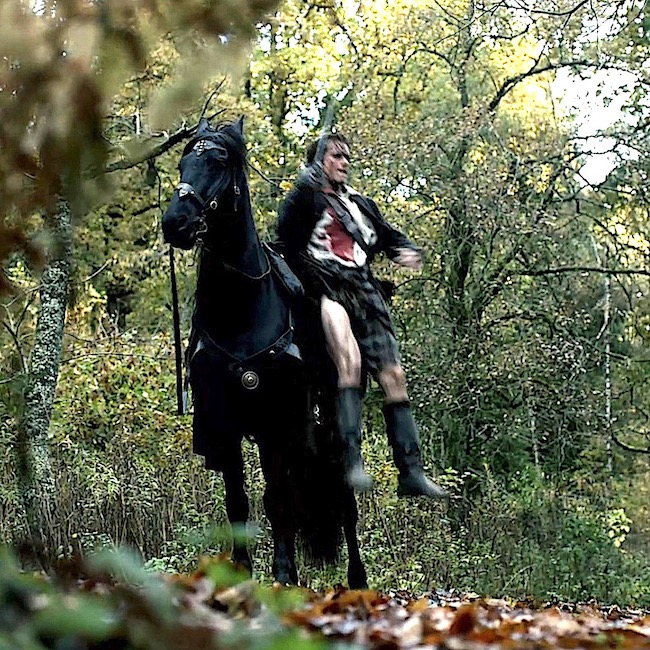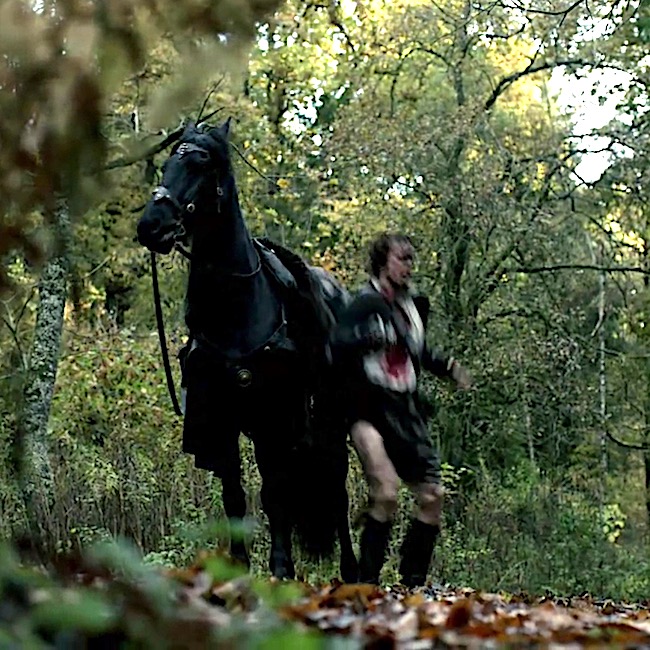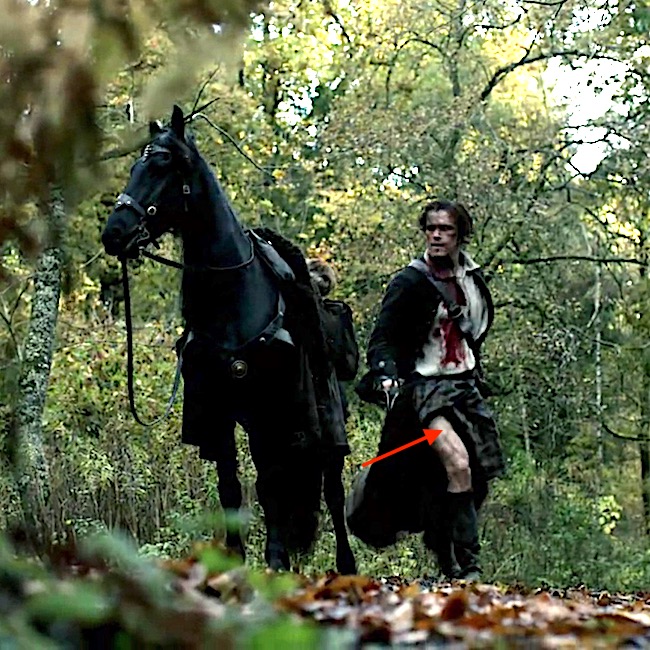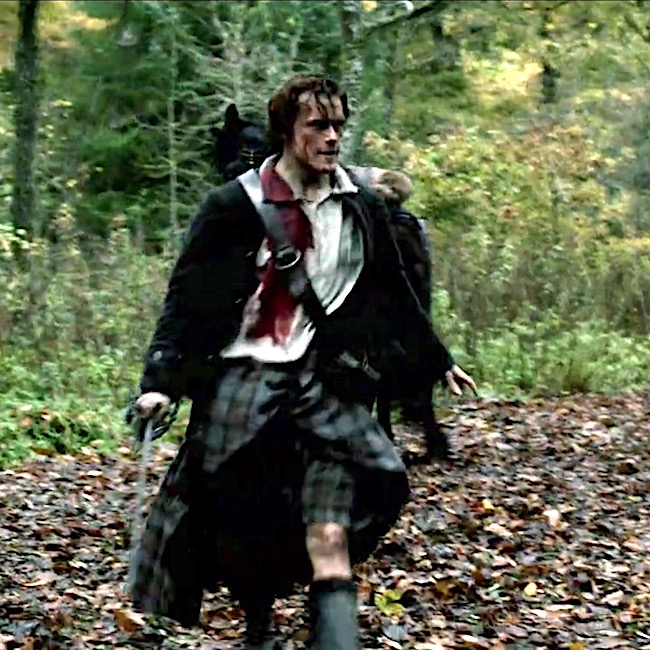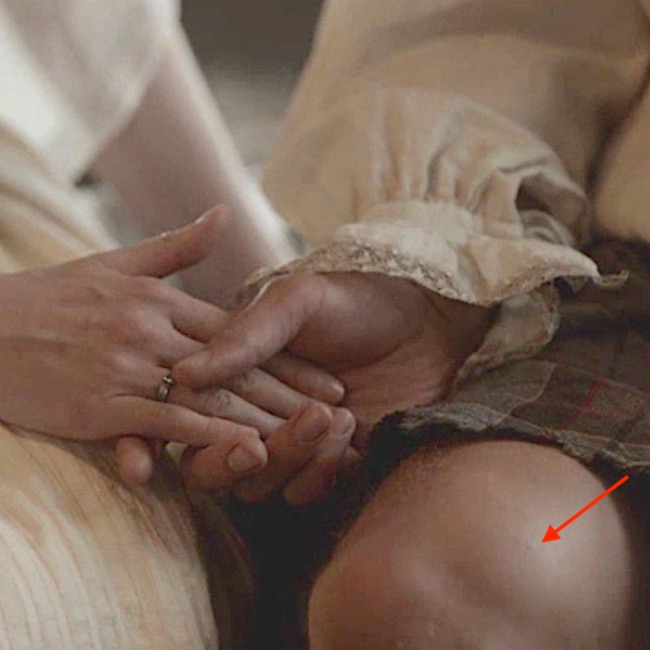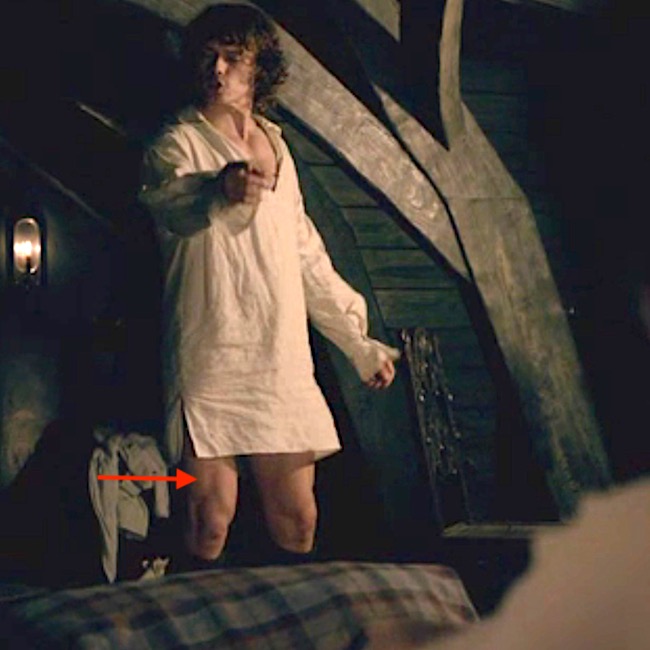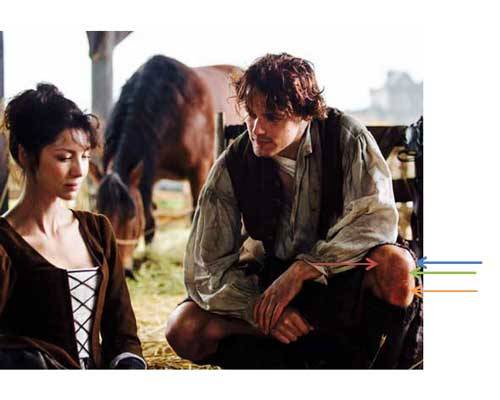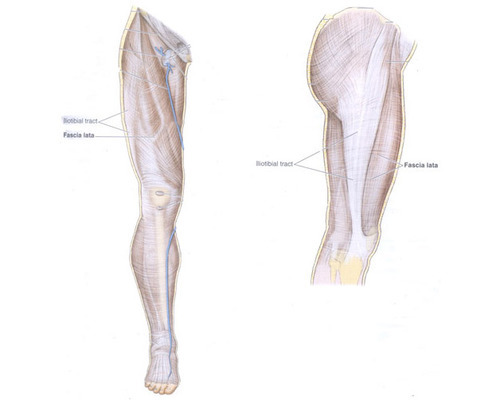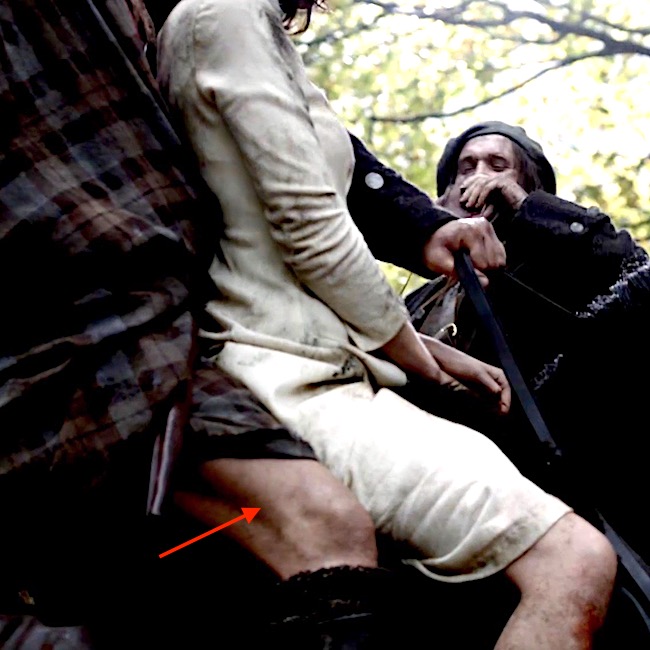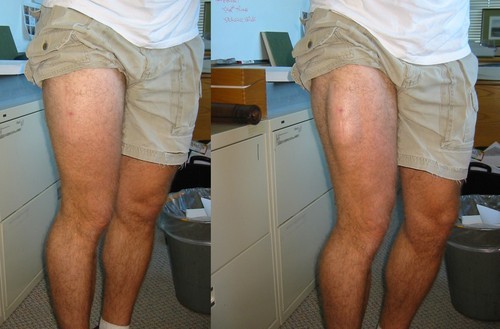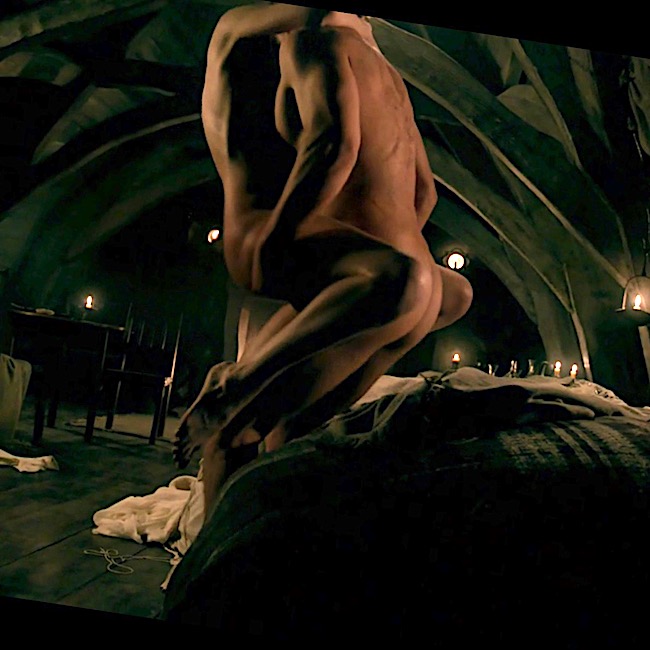Anatomy Lesson #9: Tibialis Anterior, Femoral Artery and Intestines.
Holiday greetings fledging anatomists! Hope ye have been good since my last post. This lesson follows Starz episode 4, The Gathering. It also contains lots o’ anatomy so let’s begin!
Warning: if ye havna seen episode #4 or are a wee bit squeamish, this post contains a graphic photo of Geordie’s innards; ye’ll get a second warning just before it comes inta view.
Starting off, I nearly choked on me ale when naughty Angus, that shagger of wee beasties, offers Claire a look-see under his kilt! Claire’s no likely to forget that sight! Speaking of kilts, at the end o’ this lesson I’m gonna show ye what is under a Scotsman’s kilt. But, dinna be scrolling to the end just yet! Ye will want ta read through yer anatomy lesson first…
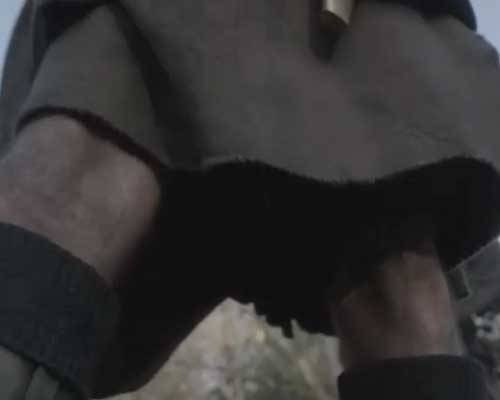
Claire is headed out on the hunt thinking boars are just wee, hairy piggies. Our stylish lassie is outfitted in the latest over-the-shoulder, wicker medical basket wit’ a fine leather strap.
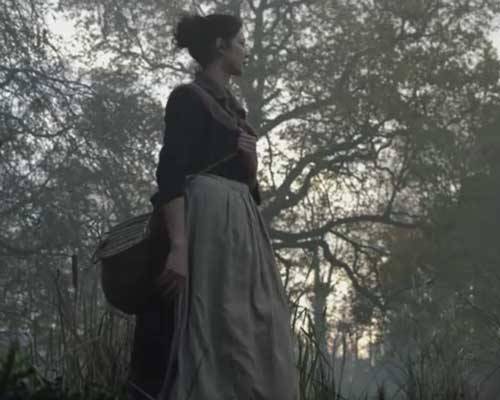
But, her first physicking is fer a young man gored by a boar. Near the knee, a horrific meaty-looking wound gapes the length o’ his right leg (see Anatomy Lesson #7). The gash is huge and Claire applies a nice field dressing while givin’ him holy hell fer messin’ wit’ the pigs. She tells him he will walk with a limp!
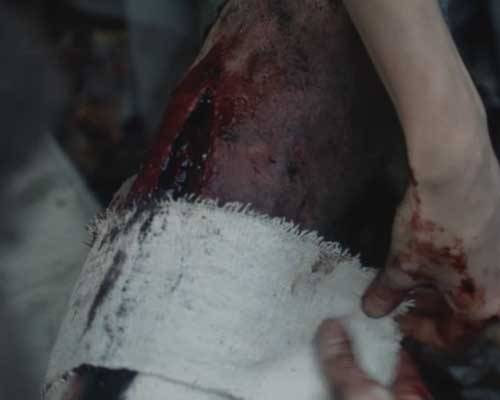
Now, let’s puzzle out the anatomy of this wound. Ye may ken from Anatomy Lesson #7 that anatomists divide the lower limb into thigh, leg and foot. Ye also ken that the leg contains two bones (Photo A): the larger, medial tibia and the smaller, lateral fibula. The tibia, or shin bone, has a sharp anterior border and a broad medial surface ye can easily palpate (feel) through yer own skin. Try it. These tibial surfaces are so superficial that they are easily barked on projections such as stair risers.

Photo A
The gash (indicated by the red dashed line in Photo B) runs the length of tibialis anterior (Photo B, black arrow) a fleshy leg muscle just lateral to the anterior tibial border. Test yer own tibialis anterior muscles this way: wit’ the legs side-by-side, stand on yer heels. Ye’ll see fleshy bumps to the side of each tibia – the tibialis anterior muscles. If yers aren’t verra fleshy, read on ta find out how to strengthen them!
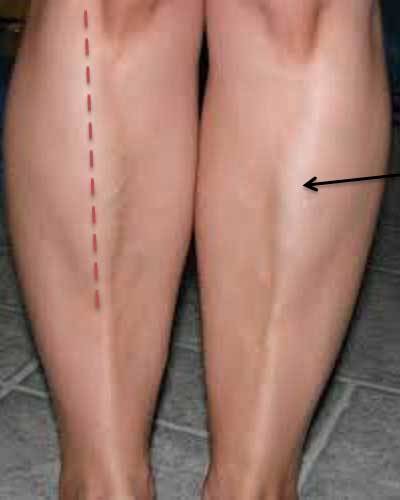
Photo B
Tibialis anterior arises (takes origin) from the tibia, turns into tendon, angles across the ankle joint and ends (inserts) on foot bones near the instep (Photo C). It has two major functions: it inverts the ankle (the sole faces the midline) and it lifts the foot at the ankle (dorsiflexion) allowing the toes to be pulled up and held in a locked position. This muscle is critical for walking, running, kicking a ball, or any activity that requires moving the leg or keeping the leg vertical. Now ye ken why Claire warns the young man that he will walk wit’ a limp.
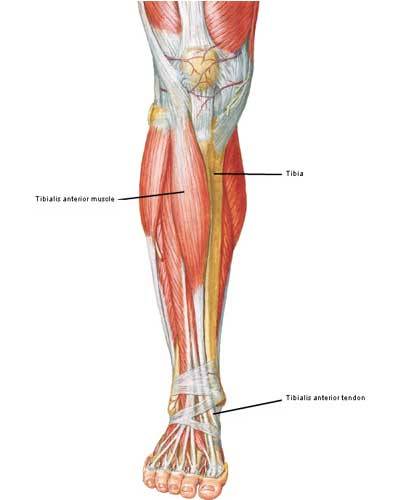
Photo C
Ye can strengthen yer own tibialis anterior using a verra simple exercise (Photo D). Tie an exercise band around an upright, place the loop over the foot (not just the toes) and dorsiflex the foot against tension. Repeat on the other side gradually increasing the number of repetitions over time. Ye can also find tibialis anterior strengthening exercises on YouTube.
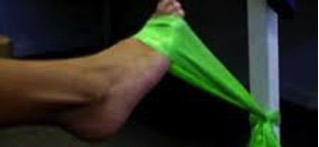
Photo D
TAKE NOTE! Flawed running technique, poor athletic shoes, overuse, etc., can cause tibialis anterior muscles to become seriously inflamed (redness, swelling, pain, heat, and loss of function). In Photo E the inflammation is so extensive ye can see the entire course o’ the muscle and its tendon just under the skin!
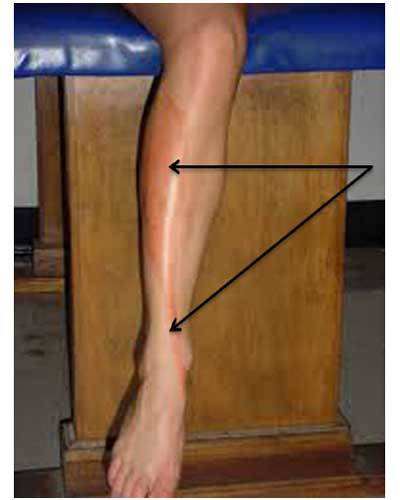
Photo E
Movin’ on: Claire’s next challenge is puir Geordie whose gory thigh bears multiple lacerations from a boar’s tusk! Claire correctly concludes that the gouges missed his femoral artery because there is no spurt ta the blood flow.
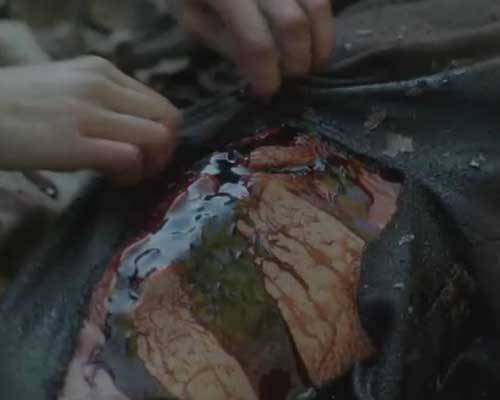
Where is Geordie’s femoral artery? Weel, the (common) femoral artery starts at the inguinal ligament accompanied by a vein and nerve of the same name (Photo F). It bears another name before passing behind the inguinal ligament but it doesn’t concern us just now. Soon, (2-3 inches) it passes behind the sartorius and vastus medialis muscles (see Anatomy lesson #7) too deep fer a boar tusk ta reach.

Photo F
Ready fer a wee bit o’ self-examination? Or, ye can play doctor with a friend!…Snort! Lie on your back and put yer fingers in the groin near the middle of the thigh. Move them up and down. Do ye feel a thick band? This is the inguinal ligament (Photo I – black arrow). Next, place yer middle and ring fingers just below the inguinal ligament and press deep. Ye should feel a strong, even pulse; this is the femoral artery! It lies deep just below the middle o’ the inguinal ligament (Photo G – green arrow). It is often as big as yer thumb because it supplies blood to the entire lower limb (almost).
Hint: ne’er take a pulse with yer thumb or index finger as these vessels have their own pulses that may interfere wit’ yer assessment. The femoral artery is catheterized for diagnostic purposes and medical intervention.
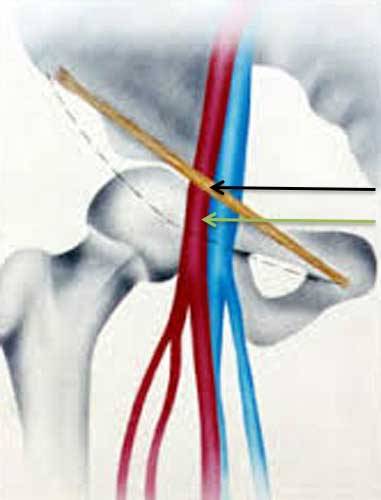
Photo G
Weel, if Geordie’s femoral artery wasna gored, where did all that dark blood come from (ye ken that arterial blood is bright red and venous blood is deep red). It came from tributaries of the great saphenous vein (GSV), the longest vein in the body (Photo H)! Saphenous is from the Greek meaning “to manifest” because often it can be seen through the skin. The GSV begins in the foot and courses up the inside of the leg and thigh ending in the femoral vein. It receives numerous tributaries (dashed oval in Photo H) along its path and these are the sources of Geordie’s blood. Claire stems the bleeding with a tourniquet knowing that she can stitch the lacerations and save his leg.
WARNING: The next image shows Geordie’s gut wound. Scroll past if ye dinna wish to see it!
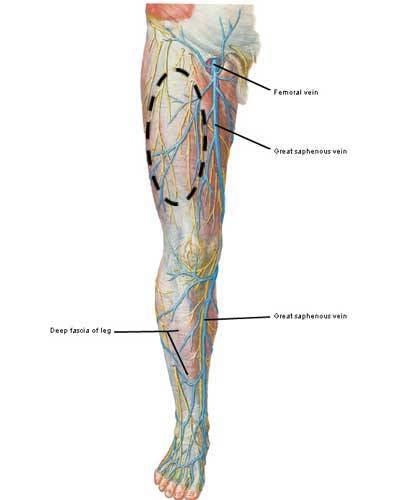
Photo H
But, sadly, Claire kens puir Geordie’s other wound: a hugh gash through the belly wall exposing globs of yellow fat (green arrows) and loops o’ intestine! This wound will be fatal in the 18th century and can be today because it exposes a normally sterile space to the outside world wit’ its teeming hordes of bacteria! She canna do anything fer him except take him ta a peaceful place! Kind Claire!
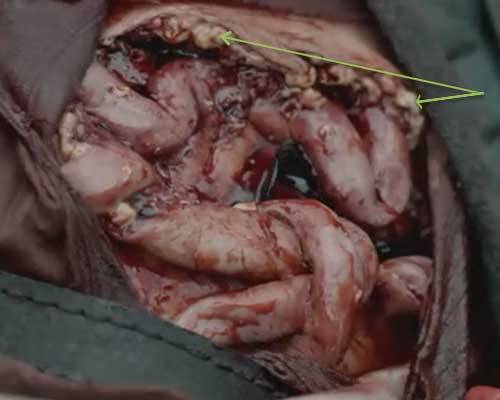
As anatomists, we should learn from Geordie’s wound. The loops shown are o’ small intestine; how do we ken that? Easy! Inspect the loop surfaces and see that they are smooth so this is small intestine; if the loops have pouches (haustra) then it is large intestine (see Photo I – black arrows). The small intestine is divided into duodenum, jejunum and ileum but we see only jejunum and ileum as the duodenum lies too deep.
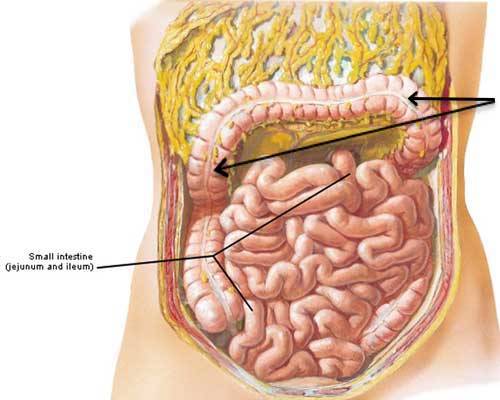
Photo I
BTW, again verra good special effects because globs of yellow fat show just under Geordie’s belly skin. Anatomists call this layer the superficial fascia of the anterior abdominal wall. But, a shorter name is Camper’s fascia (Photo J). The depth of the fatty layer depends on us. The more belly fat, the thicker Camper’s fascia; the leaner we are, the thinner Camper’s fascia! Clearly, Geordie is a slim-Jim.
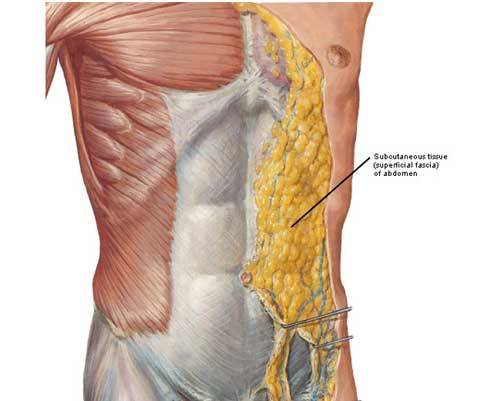
Photo J
After Claire telegraphs puir Geordie’s fate, Dougal cradles him gently in his arms (finally a kind deed!) – we hear them reliving fun times together…stealing kine, terrorizing the neighborhood, swiving Geordie’s bonny sister Doreen. What’s a guid friend fer, aye?
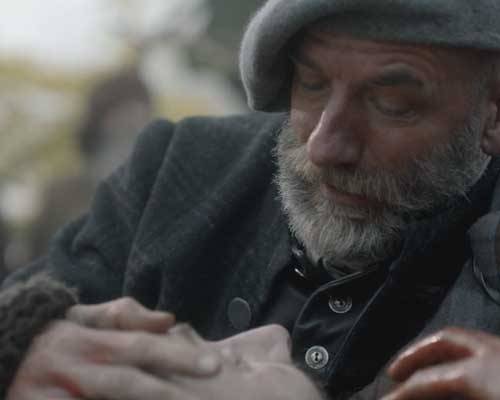
Next, Dougal arrives at the shinty field leading a horse carrying puir Geordie wrapped in a plaid death shroud (the great kilt scores again!). A rough but good-spirited game is in progress. Is it Geordie’s death or seein’ his damn nephew playin’? Either way, a black-clad Dougal roars onto the field like an 18th century Darth Vader (and boy! Isn’t he in braw, shinty-fighting form!)! He is filled wit’ rage and looking fer victims!
OK, time fer an anatomy review pop quiz! So, please git out paper and pencil and keep score…
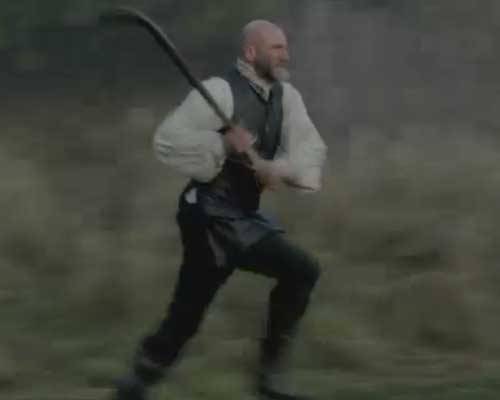
First, Dougal clips an unwitting player from behind! Dirty pool! (Hey, who’s that running ahead o’ Unca D. and victim #1)? Clipping in the US version of football has been banned for almost 100 years (one type is still permitted in the NFL and CFL). Why is clipping so dangerous? Can ye puzzle it out?
Anatomy quiz question #1: Clipping puts what knee structures at risk?
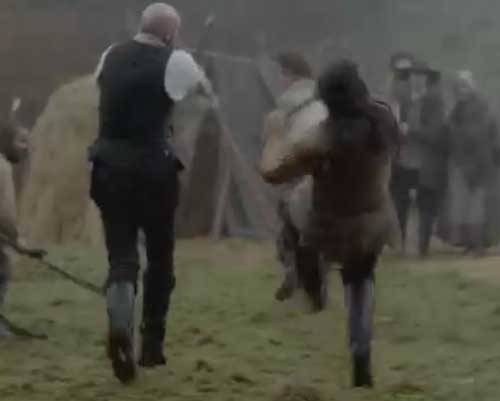
If ye answered the medial or collateral ligaments and/or the medial or lateral meniscus (see Anatomy Lesson #7) then give yerself 15 points!
A wee aside: why doesn’t Dougal ever wear a kilt? He’s always dressed in breeches. I’d love ta know what the dickens that is all about! Mayhap he gits saddle sore or is jealous of Jamie’s knees? He seems jealous of everythin’ else about the lad!
Next, Dougal shoulders a friend or foe into the fire pit!
Anatomy quiz question #2: What body part(s) does Dougal use to shove the man into a fiery pit?
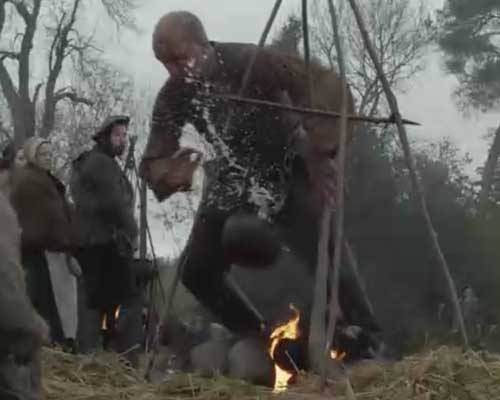
If ye answered acromion, point of shoulder and/or arm (see Anatomy Lesson #2 and Anatomy Lesson #3) then give yerself another 15 points!
Then, Dougal goes after Jamie big time. Whoa! Watch out Big Red! Yer ever lovin’ uncle is after ye!
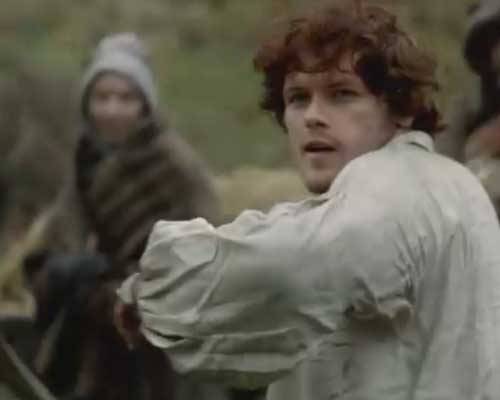
Then, Angus (he looks so funny in his poufy kilt) joins the fray ta help Dougal beat up on Jamie. Murtagh, Jamie’s ever watchful god-father, stops Angus in his tracks wit’ a shinty stick to the nether regions! Sorry Angus, but ye shouldna ha’ been so cheeky strutting yer stuff to Mistress Beauchamp!
Anatomy quiz question #3: What body part(s) did Murtagh hurt?
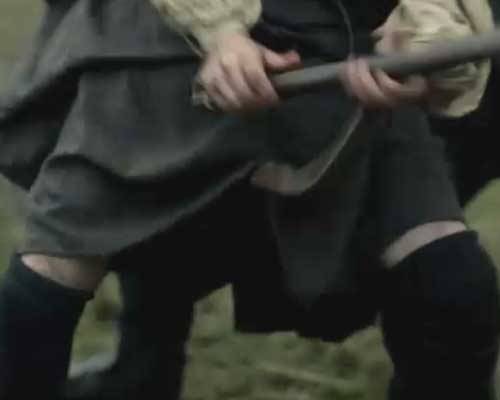
Weel, ye dinna need an anatomy lesson ta’ figure this one out! If ye answered testicles, baws or any of at least 100 other names, then gie yerself 50 points! Yep. Ye ken these parts are super important and worth a whole lot more points! Ouch! Nothin’ does it like a good whack ta the stones – and I don’t even ha’ any! I havena taught an Anatomy Lesson yet on these goodly body parts but I likely will.
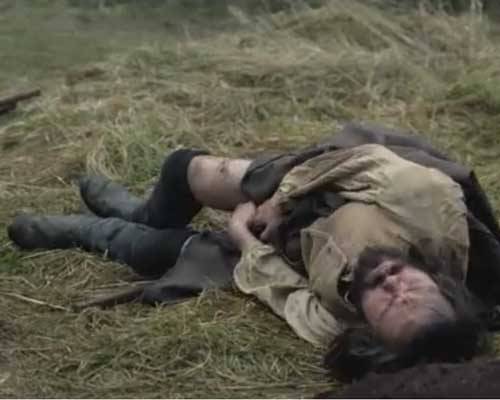
Then Dougal and Jamie go at it over the shinty ball followed by a mess o’ blows ta Jamie who remains the high born Scottish gentleman that he is! Finally, Jamie has enough and wit’ a great heave, hoists Dougal o’er his right shoulder!
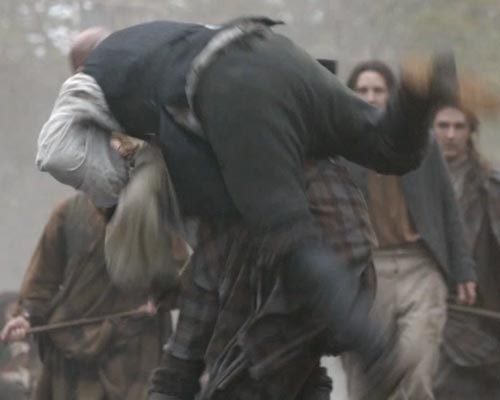
Anatomy quiz question #4: What body part might Jamie hae damaged wit’ this mightly effort (Dougal is a big man, aye)?
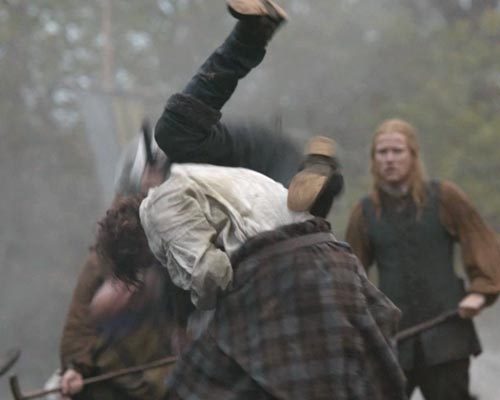
If ye said shoulder joint re-dislocation (see Anatomy Lesson #2) then gie yerself another 20 points!
When I saw Jamie standin’ there nodding to Claire (he always knows right where she is) with his right shoulder droopin’ and his palm turned backwards me thinks, CRAP, he’s done it again!
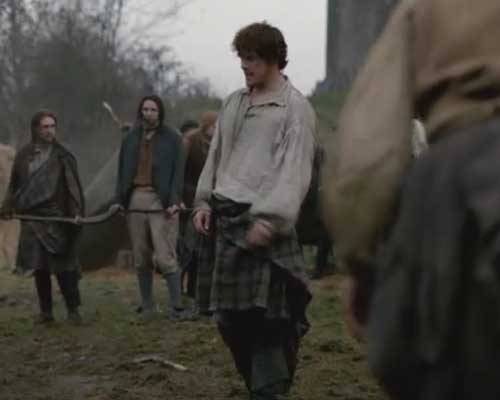
What do I mean? Weel, once a shoulder has been dislocated, it’s much easier another time. Also, the position of Jamie’s drooping right upper limb is consistent wit’ an anterior dislocation which looks like this (Photo K – ken the black arrow on the acromion?):
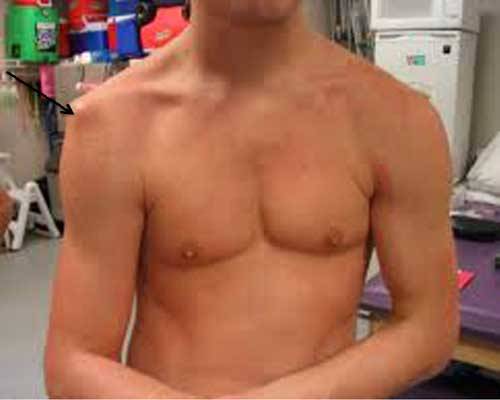
Now adding up the points, what was yer final score? Kudos if it was 100%!
Now, I’m done wit’ this anatomy lesson, but I have more ta say about “The Gathering”. I just canna help meself!
I thought Claire is the only time traveler at Castle Leoch, but no, there are two others! First, there’s the lovely Fiona and Mrs. Fitz is sharpenin’ claws on her!
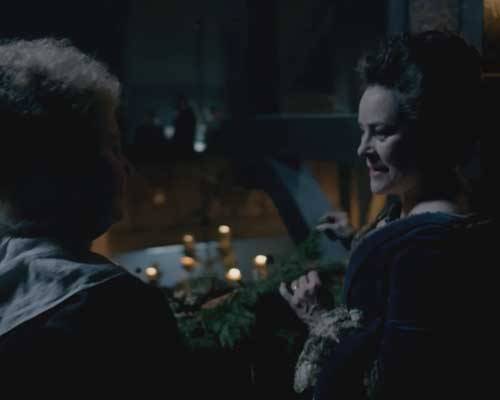
Then, there’s the elegant, hand wavin’, finger pointin’ Moore! He looks mighty dapper!
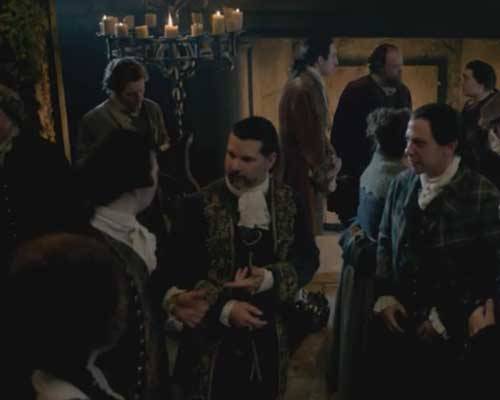
Next, I love where Murtagh explains the oath takin’ ta Claire. I swear she is the only woman he ever speaks to. Mayhap ‘tis because her smile is as sweet as Jamie’s mother? And, that gown! OMG! Terry and her team work their magic again!
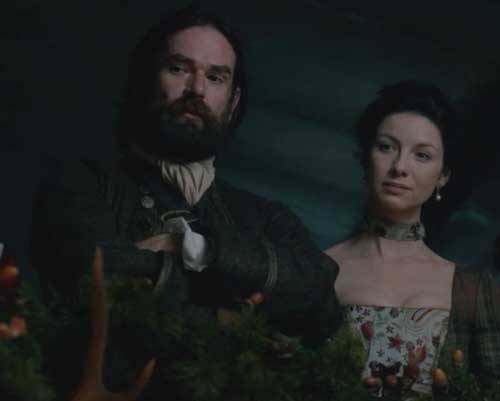
Then, the hilarious scene between Claire and Angus over the “Spanish” sedative. Ha! She even spits her mouthful of port on the floor. Oh yeah, Claire! That is more like it – she an irreverent leddy wit’ a wicked sense of humor! If she and Angus weren’t at such odds, they’d probably be besties!
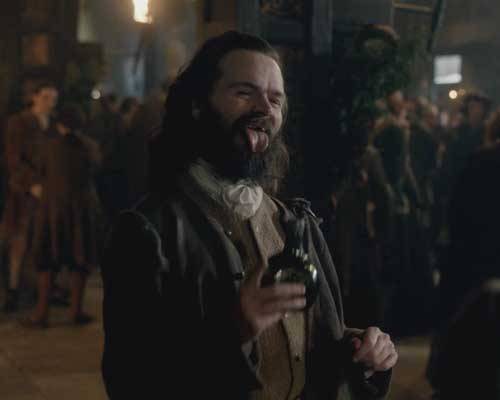
Next, I must riff on Claire’s cynical horse dung love potion for an unsuspecting Jamie. Handing it to that nasty lassie LogHair, Claire instructs her to scatter it on his threshold, click her heels together three times and recite “There’s no place like love,” “There’s no place like love.” I dinna ken if ye recognize it but this line is straight out of the Wizard of Oz where the Good Witch of the North tells Dorothy to click her heels together three times and repeat “There’s no place like home,” “There’s no place like home!” Since the W of O was released in 1939 Claire could have seen it at a cinema. If ye believe in time travel, then it’s possible!
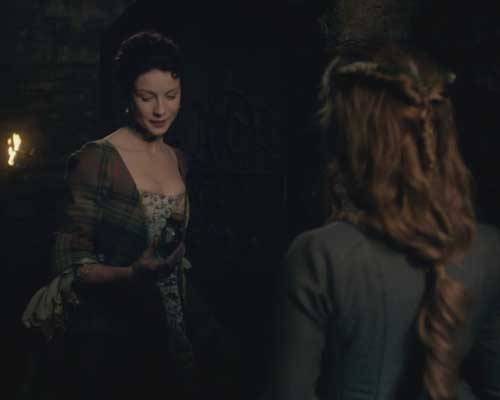
Finally, I love the intimate scene where Claire stumbles over Jamie in the stables. Fichu and ribbons not-wit’-standing, she left a trail of bread crumbs to mark her escape route? Ha! People, this is verra funny! I live in a forest and bread crumbs willna last more than a few minutes wit’ all the furry, wee beasties around. Would it be different in 18th Century Scotland?
After some difference of opinion, Claire reveals she walloped Dougal over the head with a chair. Jamie rubs the back o’ his heid sayin’ he hopes she left a good mark so Dougal will remember his error in judgment. Mayhap his rubbin’ is in sympathy fer puir Dougal? More likely, he’s feelin’ a 6” scar on the back o’ his own heid left by a wicked Lochaber ax (from the Outlander book) – likely wielded by his connivin’ uncle Dougal!
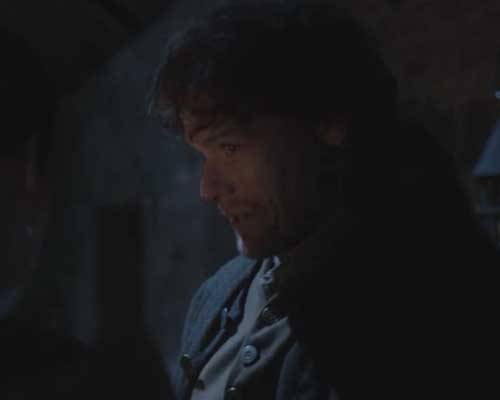
Here’s what one o’ those wicked 18th century things looks like:
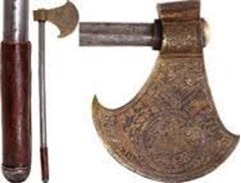
OK, I’m leavin’ ye wit’ the photo I promised at the start o’ this lesson: what does a Scotsman wears under his kilt? I added the star, ye ken? Back in 2004 when this photo was taken, Queen Elizabeth did indeed visit the 1st Battalion of Argyll and Sutherland Highlanders. If ye wish ta see the full monty (I’m bettin’ ye do) then search online fer “Scotsman seated next to the Queen” and up, er, pops the whole kilt and kaboodle! Ha! This photo is a bit o’ an urban legend and Snopes rates it as un-determined authenticity. But, the Colonel (Snopes identifies him) sports such a cheeky grin that I canna help thinkin’ the photo is likely real – but, this man is no saying one way or the other!
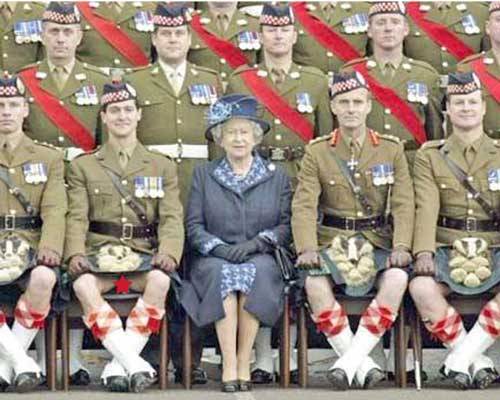
I do hope ye enjoyed this post. Please tune in 14 days from now for Anatomy Lesson #10, Jamie’s back! Until then, I wish ye the happiest of holiday seasons. Be safe! Take good care of yer amazing bodies!
Be sure to follow me on Facebook and Twitter!
The deeply grateful,
Outlander Anatomist
All photos are credited to Starz,Netter’s Atlas of Human Anatomy 4th ed., Hollingshead’s Textbook of Anatomy, 5th ed., www.wikihow.com, www.wikipedia.org, Bodyspace.bodybuilding.com, www.sportsmed.or.nz, www.Radiopaedia.or, www.Wikipedia.org, www.home.southernct.edu, www.williammitchellsstudio.com, www.bodyspace.bodybuilder, www.thesportsphysio.wordpress.com, www.pinterest.com

